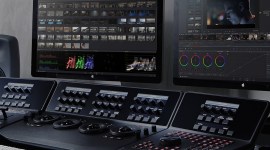
5 Reasons to Get a Color Grading Control Surface
A control surface is an essential piece of gear for professional color correction. Here are five good reasons why.
Though this is no secret to seasoned professionals, many aspiring colorists don’t realize the inherent value that a color grading control surface will bring to their work. After all, many professional software packages can be used without additional hardware.

The DaVinci control surface maps many of Resolve’s functions to dedicated buttons and knobs, making grading a breeze. However, its hefty price tag is out of reach for many. Luckily, third-party surfaces from Tangent, JL Cooper, Avid and newcomer OxygenTec harness much of the DaVinci panel at a fraction of the cost. With fewer buttons and dials, you’ll be scrolling through menus to find the parameter to change, far from a deal breaker to many.
No matter which model you choose, a control surface is an essential aspect of getting any job graded and delivered on time. Let’s take a look at several specific reasons why any surface is a must for the serious colorist.

1. Speed and Multiple Actions
The biggest and most obvious advantage to using a color grading control surface is speed. With dedicated knobs, buttons, dials and wheels set to specific functions, muscle memory quickly develops as you learn your panel. When you get fast enough, color grading is no longer frustrating, it’s actually fun! You’ll be wondering how you ever did good work without a panel for this reason alone.
Speed isn’t just about jumping to specific commands to alter your image. When coloring, it’s helpful to adjust several parameters at once to see how the image reacts. This will enable the colorist to experiment with a wide range of looks to gauge a favorable client reaction.

2. Trust Me, Your Work Will Improve
Working with a panel enables an organic relationship with your images. By controlling the color wheels, you’ll intuit where the image wants to sit. The physical nature of working with your hands will also prevent you from processing every job in the same way.
Using the color wheels and dials allows for finely-tuned adjustments that are difficult to articulate with a mouse. Many times in session I push the slightest change in the hue of a skin tone to satisfy the client. The software color wheels inside Resolve are small, making these kinds of moves cumbersome.

3. Stave Off Carpal Tunnel
The ergonomic layout of every panel provides minimal strain for long grading sessions. I remember a long-form job that required me to grade several hundred shots in three days. I was awarded the job before I owned a panel, and was one of the catalysts for acquiring one.
During the job, my hand was gnarled around the mouse in just the right amount to make fine adjustments, but across a full ten-hour day, my hand began to cramp, and when the job concluded, I experienced pain in my wrist and joints. I gave my hand a break and began looking into which color grading control surface would be my best option.

4. Execute Actions from Other Applications
Since the control panels are dedicated instruments for Resolve, button presses continue to interact with the application, regardless of what’s in focus. If I’m browsing the Internet, I can save my project or scroll to the beginning of the timeline to play the cut for a client that just walked in.

5. Client Perception
When engaging a new customer relationship, I have to instill immediate confidence in my clients so they are confident their project will be handled professionally. Purchasing a panel is one way to forecast this. You’re showing your clientele you’re serious about the craft. What’s more, a monetary career investment now will pay off in huge ways in the future. In time, better work and more prestigious clients will follow, overshadowing the panel’s initial cost.
Consider a Control Surface Today
A writer’s control surface is a keyboard, which is fast since every letter is mapped to a specific key. Similarly, a colorist doesn’t want to click around on the screen when a gestural input is available. The nuanced nature of color benefits from having a device that is attuned to these subtleties.
I’ll admit, it took me a long time to purchase my control surface. I had numerous conversations with other professional colorists about the benefit of owning one, but until I made the purchase, I just didn’t get how much it would help me. Today, having owned my panel for years, I can firmly say it’s one of the best investments I’ve made toward furthering my craft.
If you’d like to know more about color grading control panels, here are a few resources from around the web:
- Overview: Colorist Control Surfaces – Mixing Light
- How to Decide If A Colorist Control Surface Is In Your Future – Tao of Color Grading
- Color Control Surfaces Compared – Eric Hansen.tv
Have you incorporated a control surface into your day to day work? How has it helped? Share your thoughts in the comments below.





